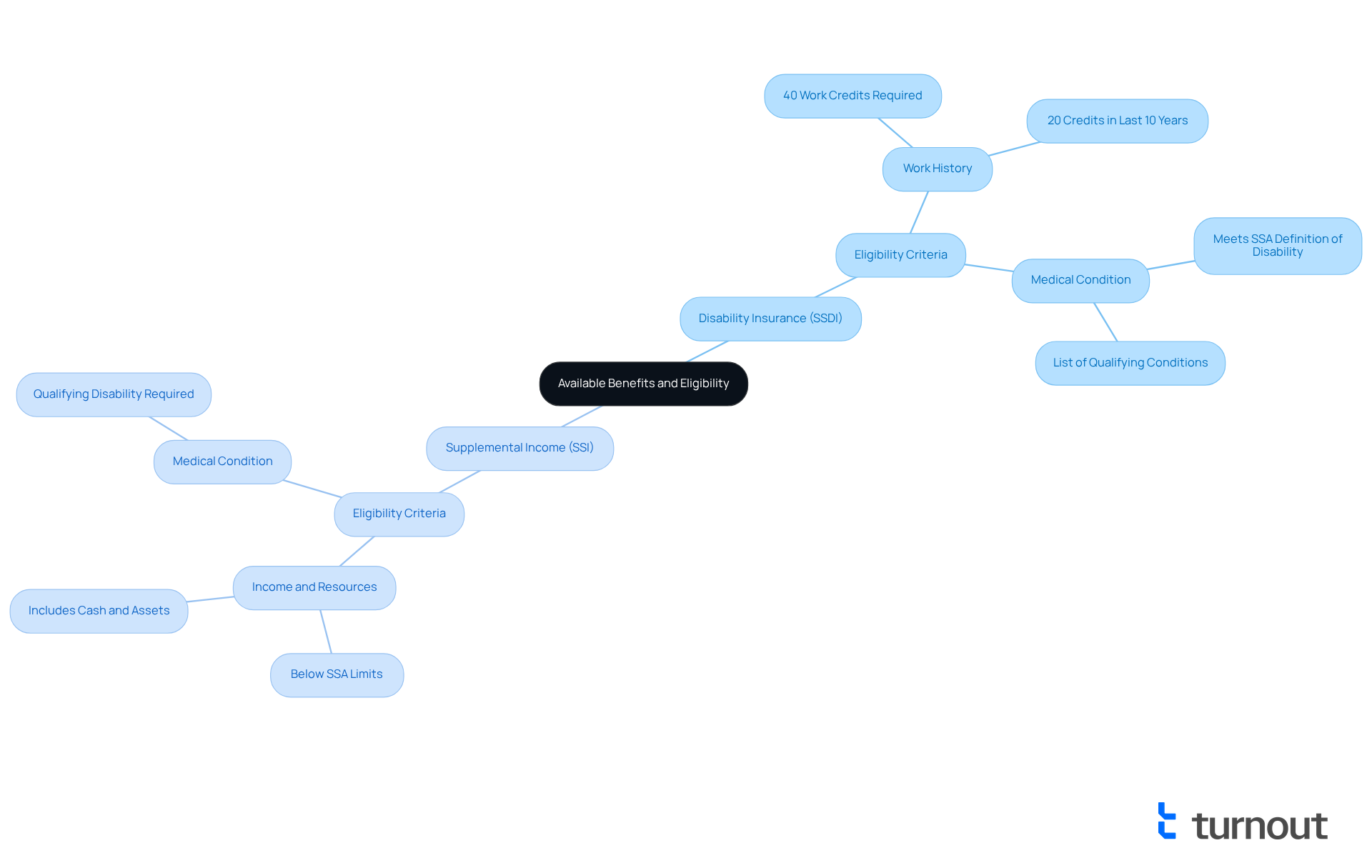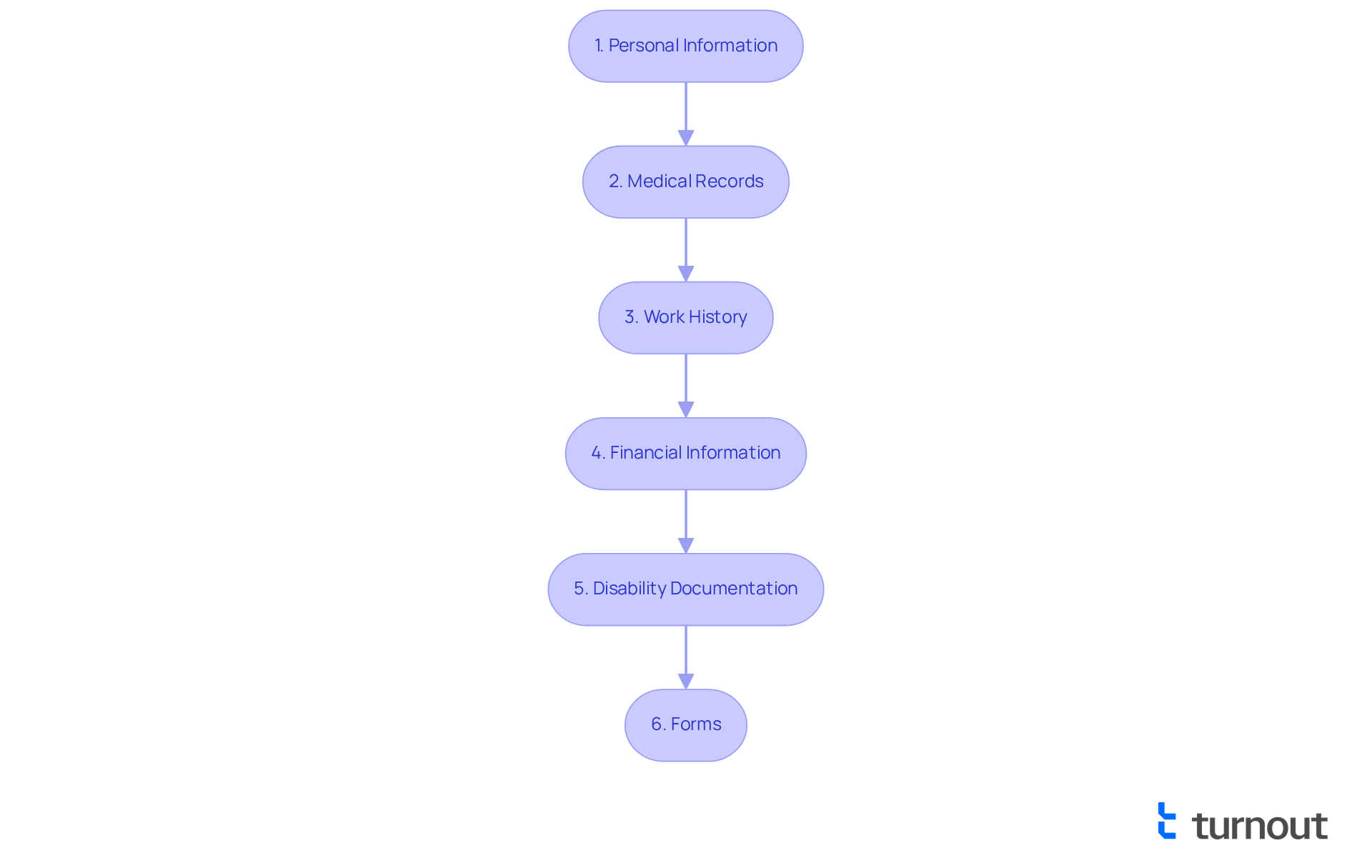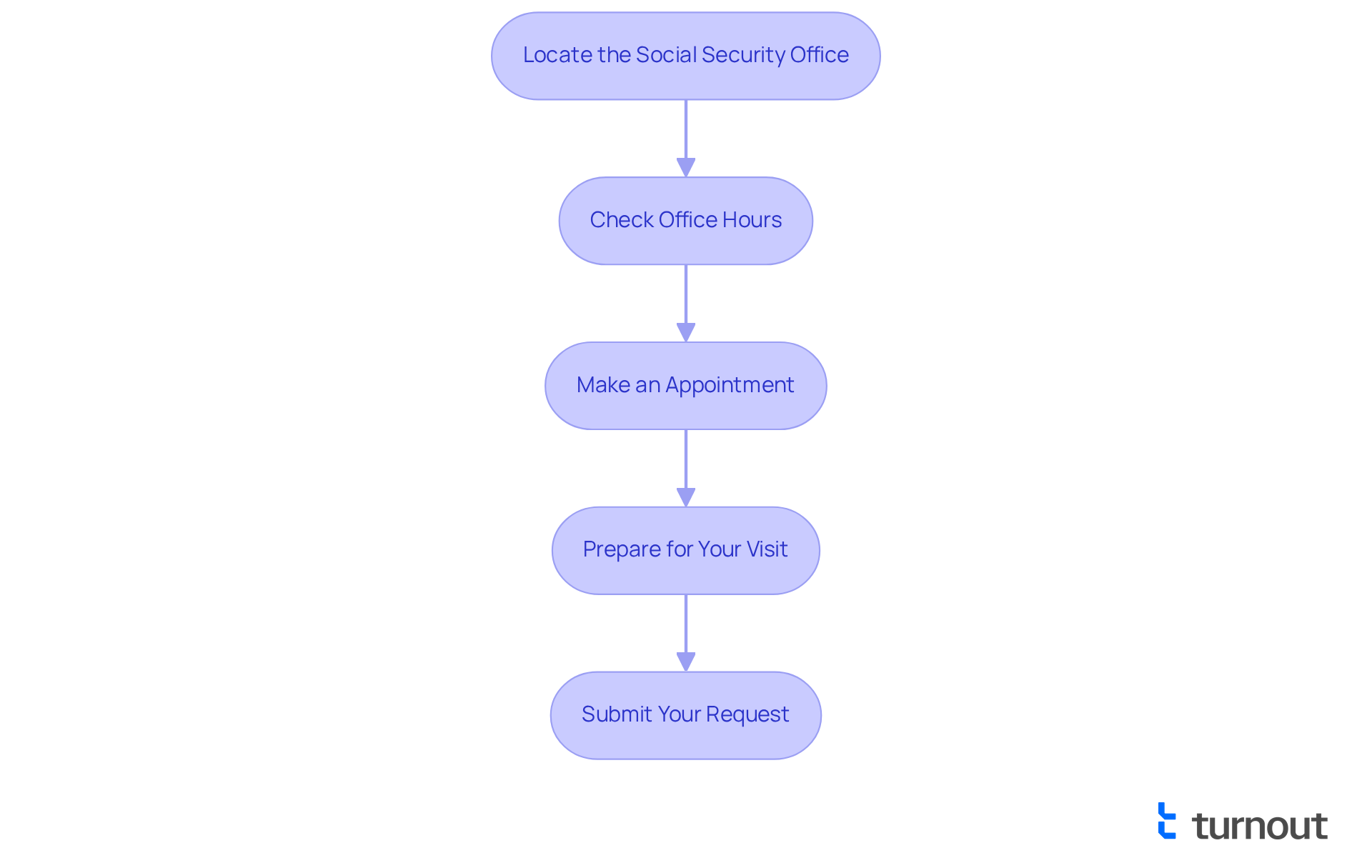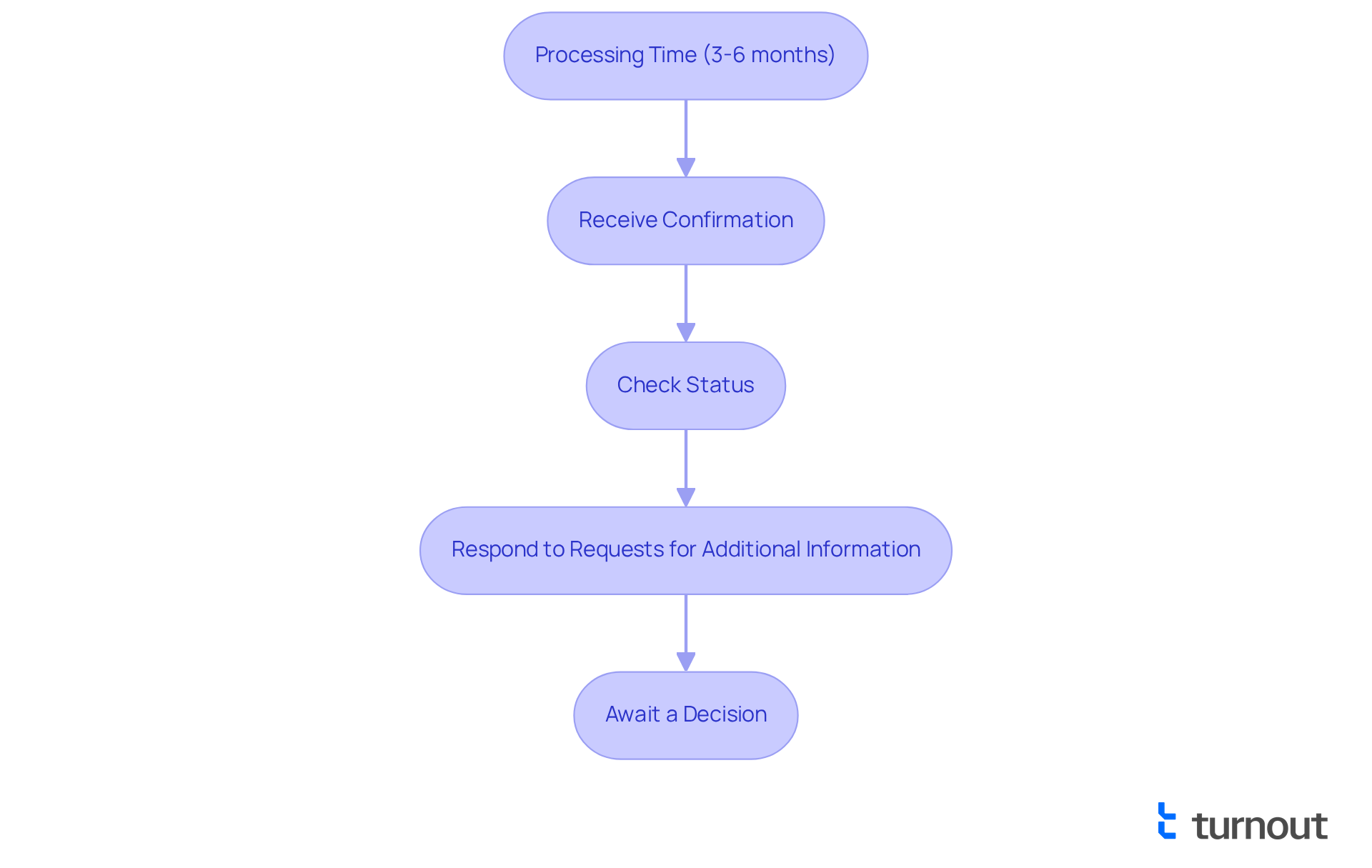Overview
Navigating the Social Security Office in Mobile, AL, can feel overwhelming. We understand that you may have questions about available benefits and the documentation needed. This journey involves a structured submission process, but you are not alone in this.
This article will guide you through the essential steps for gathering information, submitting applications, and following up. We emphasize that thorough preparation and a clear understanding of eligibility criteria can significantly enhance your chances of a successful outcome.
By taking the time to prepare, you can approach this process with confidence. Remember, we’re here to help you every step of the way. You deserve support as you navigate these important decisions.
Introduction
Navigating the complexities of the Social Security system can often feel like an uphill battle. We understand that seeking assistance in Mobile, Alabama, can be especially challenging. It's crucial to understand the various benefits available, such as Disability Insurance and Supplemental Income, for anyone looking to secure financial support. But what happens when the process becomes overwhelming?
This guide offers a clear, step-by-step approach to help you prepare your applications, submit them effectively, and follow up with confidence. Remember, you are not alone in this journey toward securing your rightful benefits. We're here to help you every step of the way.
Understand Available Benefits and Eligibility Criteria
Before seeking assistance, it’s important to understand the different types of benefits available and the eligibility requirements for each. We recognize that navigating this process can be overwhelming, but we’re here to guide you through it. The two primary types of benefits you may encounter are:
-
Disability Insurance (SSDI): This program is designed for individuals who have worked and contributed to taxes for a specific number of years. To qualify, you must have a medical condition that meets the Social Security Administration's (SSA) definition of disability.
-
Supplemental Income (SSI): This program is aimed at individuals with limited income and resources, regardless of their work history. To qualify, applicants must demonstrate financial need alongside a qualifying disability.
To determine your eligibility, consider the following criteria:
- Work History: For SSDI, you generally need to have earned at least 40 work credits, with 20 earned in the last 10 years before your disability began.
- Medical Condition: Both programs require that your condition significantly limits your ability to work. The SSA maintains a list of medical conditions that automatically qualify for benefits, but many other conditions may also qualify based on individual circumstances.
- Income and Resources: For SSI, your income and resources must fall below specific limits set by the SSA. This includes cash, bank accounts, and other assets.
In 2025, the maximum federal payout for SSI will increase to $967 per month, reflecting ongoing adjustments to support low-income individuals. Additionally, it’s important to stay informed about updates to SSDI eligibility, including changes to work credit requirements and the Substantial Gainful Activity (SGA) limits.
Please remember, Turnout is not a law firm and does not provide legal advice. We are not affiliated with or endorsed by any law firm or government agency. For more detailed information on tax debt relief services and benefits, we encourage you to visit the SSA's official website or consult with a knowledgeable representative who can help clarify your specific situation. You are not alone in this journey; we’re here to help.

Prepare Your Application: Gather Documentation and Information
Preparing your submission can feel overwhelming, but gathering essential documentation and information to support your claim is a crucial first step. We understand that this process can be daunting, so here’s a step-by-step guide to help you through it:
- Personal Information: Start by collecting your Social Security number, birth certificate, and contact information. This foundational step is vital for your submission.
- Medical Records: Next, obtain detailed medical records from your healthcare providers. This includes diagnoses, treatment history, and any relevant test results. Remember, it’s important to ensure these documents are current and comprehensive, as the average time to gather medical records can vary significantly, often taking several weeks.
- Work History: Prepare a detailed work history that includes the names of employers, job titles, and dates of employment. This information is essential for SSDI submissions, as it helps determine your eligibility based on work credits.
- Financial Information: For SSI applicants, gather information about your income, bank statements, and any other financial resources. This will help demonstrate your financial need, which is a key factor in the approval process.
- Disability Documentation: If applicable, include any documentation that supports your claim of disability, such as statements from healthcare providers. It’s important to note that comprehensive medical records are vital, as they significantly impact the likelihood of approval.
- Forms: Lastly, download and fill out the required forms from the SSA website. Make sure that all sections are filled out accurately to avoid delays.
Having all these documents prepared will simplify the submission process and decrease the chances of delays or requests for extra information. Remember, claimants who are well-prepared often experience a smoother journey through the SSDI process, increasing their chances of receiving benefits. You're not alone in this journey, and we're here to help you every step of the way.

Submit Your Application: Navigating the Social Security Office in Mobile, AL
Once you have gathered all the necessary documentation, we understand that submitting your application can feel overwhelming. Let’s walk through how to navigate the Social Security office in Mobile, AL, together:
- Locate the Social Security office mobile al: The Social Security office in Mobile is conveniently located at 550 Government St, Suite 100, Mobile, AL 36602. You can use online maps or the SSA office locator tool to find your way.
- Check Office Hours: The office operates Monday to Friday from 9:00 AM to 4:00 PM. To make your visit smoother, consider avoiding peak hours, especially early mornings. It’s reassuring to know that the office has resumed in-person service without requiring appointments, which can be a relief for those who prefer to visit directly.
- Make an Appointment: While walk-ins are welcome, scheduling an appointment can significantly reduce your waiting time. Many individuals have found that those who schedule appointments experience shorter wait times compared to those who walk in without one. You can call the office at (866) 593-1922 to set up a time that works for you.
- Prepare for Your Visit: It’s important to bring all your documentation, including filled-out forms. Consider preparing a list of questions or concerns to discuss with the staff. Advocates emphasize that being well-prepared can enhance your experience and ensure that all your needs are addressed during your visit.
- Submit Your Request: Upon arrival, check in with the receptionist and follow their instructions for submitting your request. Don’t forget to obtain a receipt or confirmation of your submission for your records.
By following these steps, you can feel confident that your submission will be completed accurately and efficiently. Real-world examples indicate that individuals who are organized and proactive in their approach tend to have more successful visits. Remember, preparation and scheduling are key, and we’re here to help you every step of the way.

Follow Up on Your Application: What to Expect After Submission
After submitting your application, understanding the follow-up process is crucial. We know this can be a challenging time for you, and we're here to help.
-
Processing Time: The Social Security Administration (SSA) usually requires approximately 3 to 6 months to handle requests. However, this timeframe can vary depending on the complexity of your situation and the current volume of submissions.
-
Receive Confirmation: You can expect a confirmation letter from the SSA acknowledging receipt of your submission. This letter will contain essential information regarding your case, helping you feel more secure.
-
Check Status: It's common to wonder about the progress of your request. You can track it online through your my account or by contacting the SSA at 1-800-772-1213. Be ready to provide your Social Security number and other identifying details.
-
Respond to Requests for Additional Information: If the SSA needs more information, they will reach out to you. Quickly addressing these requests is essential to prevent delays in your processing. Remember, responding promptly shows your commitment to your case.
-
Await a Decision: After processing, you will receive a decision letter. If approved, this letter will detail your benefits. If denied, it will explain the reasons for the denial and provide guidance on how to appeal the decision. We understand how important this outcome is for you.
By staying informed and proactive, you can navigate the follow-up process with confidence. Remember, approximately 38% of applicants who meet the technical requirements are accepted initially. However, many find success through the appeals process, with 53% of those who appeal ultimately receiving approval. Furthermore, it's crucial to recognize that approximately 5.4% of the adult population aged 18 to 64 in the United States received disability benefits in December 2022, emphasizing the importance of the process.
As Turnout emphasizes, utilizing trained nonlawyer advocates can provide valuable support throughout this journey. Following up on your application is essential; it shows your commitment and can help expedite the process. Importantly, Turnout is not a law firm and is not affiliated with any law firm or government agency, ensuring that the support you receive is tailored to your needs without legal representation. Turnout offers various tools and services designed to assist you in navigating the SSD claims process effectively. You are not alone in this journey, and we're here to support you every step of the way.

Conclusion
Navigating the Social Security office in Mobile, AL, can feel overwhelming. We understand that this journey may bring about uncertainty and concern. However, with the right preparation and knowledge, you can significantly ease your experience. This guide outlines essential steps, from recognizing the types of benefits available—such as SSDI and SSI—to gathering necessary documentation and submitting your application. Each phase of the process is designed to empower you, ensuring that you are informed and ready to seek the assistance you need.
It's important to understand eligibility criteria and prepare your personal and financial documents. Knowing the steps to effectively submit your application can make a difference. Additionally, we've highlighted insights into the follow-up process, including what to expect and how to respond to requests for further information. By being proactive and organized, you can enhance your chances of a successful outcome.
Remember, you don't have to face this journey alone. With the right information and support, you can navigate each step with confidence. Whether you are seeking benefits for the first time or need to follow up on an existing application, staying informed and prepared is crucial. Embracing this knowledge not only facilitates a smoother experience but also underscores the significance of accessing the benefits that can provide essential support during challenging times. You are not alone in this journey; we’re here to help you every step of the way.
Frequently Asked Questions
What are the two primary types of benefits available for individuals with disabilities?
The two primary types of benefits are Disability Insurance (SSDI) and Supplemental Income (SSI).
Who qualifies for Disability Insurance (SSDI)?
SSDI is designed for individuals who have worked and contributed to taxes for a specific number of years and have a medical condition that meets the Social Security Administration's (SSA) definition of disability.
Who qualifies for Supplemental Income (SSI)?
SSI is aimed at individuals with limited income and resources, regardless of their work history. Applicants must demonstrate financial need alongside a qualifying disability.
What is the work history requirement for SSDI?
To qualify for SSDI, you generally need to have earned at least 40 work credits, with 20 of those credits earned in the last 10 years before your disability began.
What medical condition criteria are required for both SSDI and SSI?
Both programs require that your medical condition significantly limits your ability to work. The SSA maintains a list of medical conditions that automatically qualify for benefits, but other conditions may also qualify based on individual circumstances.
What are the income and resource limits for SSI?
For SSI, your income and resources must fall below specific limits set by the SSA, which includes cash, bank accounts, and other assets.
What will the maximum federal payout for SSI be in 2025?
In 2025, the maximum federal payout for SSI will increase to $967 per month.
How can individuals stay informed about updates to SSDI eligibility?
Individuals should stay informed about updates to SSDI eligibility, including changes to work credit requirements and the Substantial Gainful Activity (SGA) limits.
Does Turnout provide legal advice regarding benefits?
No, Turnout is not a law firm and does not provide legal advice. It is recommended to visit the SSA's official website or consult with a knowledgeable representative for detailed information.




